Asian Arowanas’ history goes back to ancient times, and people adore these fish because of their beauty and size. This article guides you through keeping Red Asian Arowana at home or office because they are worth every penny you lose (and, of course, your time).
Arowanas are definitely not your usual type of pet fish that you can keep by just buying them. They need a massive tank that often is highly-priced, a lot of your time and effort than any other fish.
As mysterious as it seems, these fish are considered endangered, hence prohibited to keep in the USA.
However, Asian Arowana (or dragon fish) is a crown jewel for any experienced aquarist in the world.
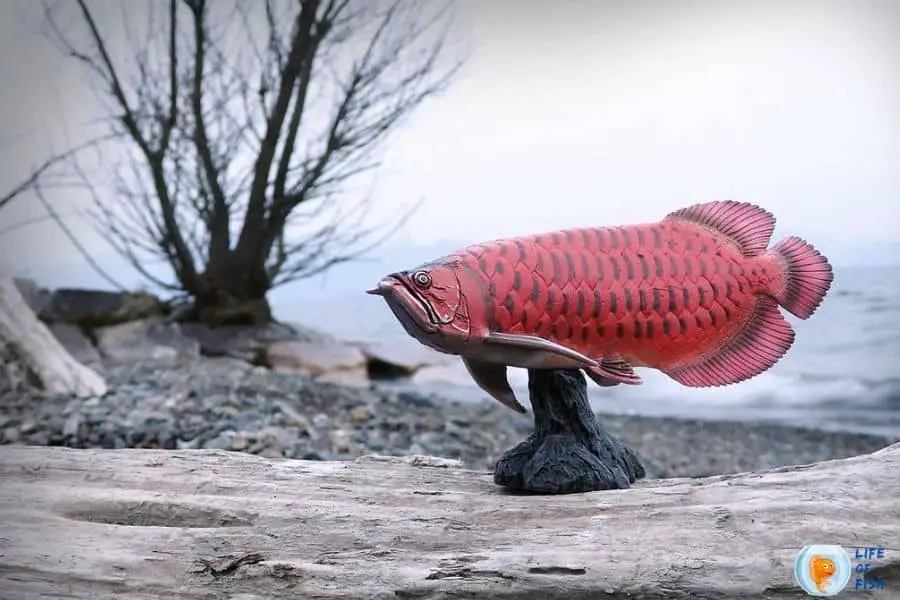
What is Red Asian Arowana?
Jump To
- 1 What is Red Asian Arowana?
- 2 Why is Red Asian Arowana illegal in the US?
- 3 How much is a Red Asian Arowana?
- 4 How big do Red Asian Arowana get?
- 5 Is Red Asian Arowana aggressive?
- 6 Red Asian Arowana behavior
- 7 How long do Red Asian Arowana live?
- 8 One look Care guide
- 9 Red Asian Arowana care
- 10 Red Arowana breeding
- 11 Special tips
- 12 How to feed Red Arowana?
- 13 What fish can live with Red Arowana?
Scientifically named Scleropages formosus, Red Asian Arowana is a bony tongue fish that hails from the Osteoglossidae family.
Naturally found in slow-moving streams and rivers in South East Asia, these fish are often called “Dragon fish” in the Chinese culture because of their Dragons-like look and the history that goes back to ancient times.
Appearance-wise, Red Asian Arowana has a long snake-like body, protruding eyes, with a strong jaw. Their scales are soft and shiny, which is what draws most people’s attention to them.
The color of the Red Asian Arowana varies from silvery white to rich Red depending on its type. However, a substantial part of its body is covered with Red.
Their huge, black eyes can be seen just beside their mouth, which is a characteristic feature of Red Asian Arowanas.
Their long pectoral fins usually connect behind the head. In addition, these species have broad anal and tail fins.
There is even a dorsal fin located near the rear portion of their body. The fins work in unison with their swim bladder to propel them through the water.
Asian Arowanas can grow up to 3 feet long, and the males are larger than the females.
Why is Red Asian Arowana illegal in the US?
Asian Arowanas, including Red Asian Arowanas, are illegal to keep in the US because they are considered endangered species.
Further, this fish is listed as endangered species in CITES.
They are also labeled by the US Fish & Wildlife Services due to high demand in Asian countries for the trade of this fish.
However, these fish are now reproduced in captivity. Those who are bred in captivity get microchipped and, these microchipped fish are legal to keep in some states in the USA under special license.
How much is a Red Asian Arowana?
Red Arowana is one of the most expensive aquarium fish in the trade. They will cost you somewhere between $500 to $5000.
According to some reports, some even sold for around $300000.
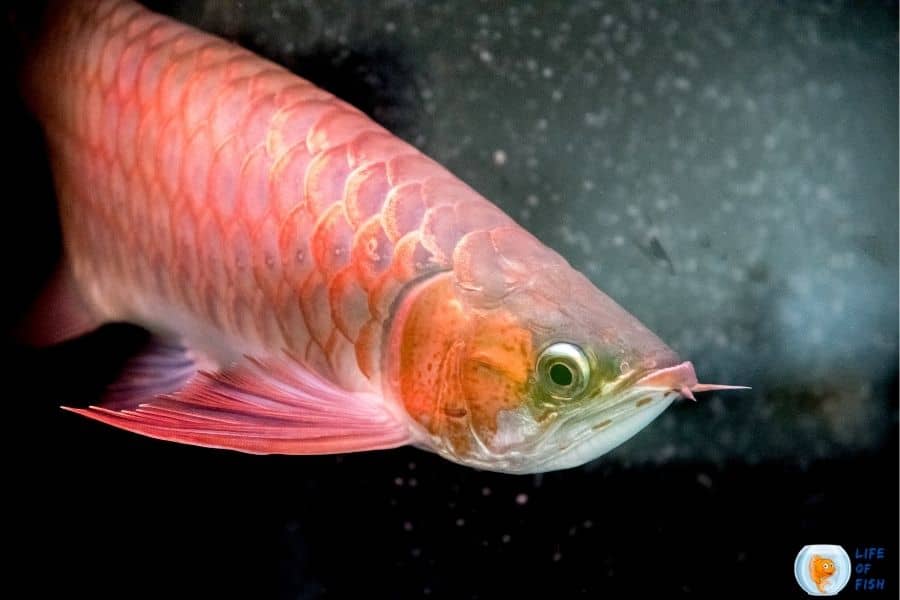
How big do Red Asian Arowana get?
It is not uncommon for an Asian Arowana to reach in weight in the range of 15 lbs.
An Asian Arowana can grow up to 3 feet, which means they are one of the largest freshwater fish ever bred.
They are also found naturally but endangered because their natural habitats have been destroyed due to development, climate change, and pollution.
Is Red Asian Arowana aggressive?
Red Arowana is an aggressive fish and should be kept alone. You can’t keep it with other fish and, the same goes for its own kind as well (they’re likely to fight).
However, Asian Arowanas are not aggressive as Australian Arowanas and can keep a group of Arowana together if introduced at their juvenile age.
Red Asian Arowana behavior
Red Asian Arowanas are usually middle dwellers and surface feeders. They tend to spend their time in the middle of the tank and feed right away when they find some food from the top of the tank.
These are highly aggressive and territorial fish. If not for food, they will attack any other fish to secure their territory.
How long do Red Asian Arowana live?
Red Asian Arowanas can live up to 20 years in captivity. They are known to live longer when they live in the wild.
One look Care guide
| Scientific name | Scleropages formosus |
| Common name | Red Asian Arowana, Red Arowana, Dragonfish |
| Care level | Moderate |
| Native to | Southeast Asia |
| Type | Bony tongue fish |
| Color | Red |
| Tank size | 250 gallons |
| Preferred temperature | 75-86° F (24-30° C) |
| Other water parameters (ammonia ,ect) | pH level- 6-7 |
| Preferred salinity | No salinity |
| Size | 3 feet |
| Life span | 20 years |
| Temperament | Very Aggressive |
| Recommended tank mates | Prefer solitary but will do fine when introduced at juvenile age. Large catfish Parrotfish Silver Dollar Fish Large Plecos Bichir Jaguar Cichlid Pacu Green Terror Cichlid |
| Preferred food | Live or frozen foods like tubifex, brine shrimp, small fish, shrimps, or daphnia |
| Feeding frequency | Twice per day |
| Breeding | Egg-laying mouthbrooders, impossible in a home aquarium |
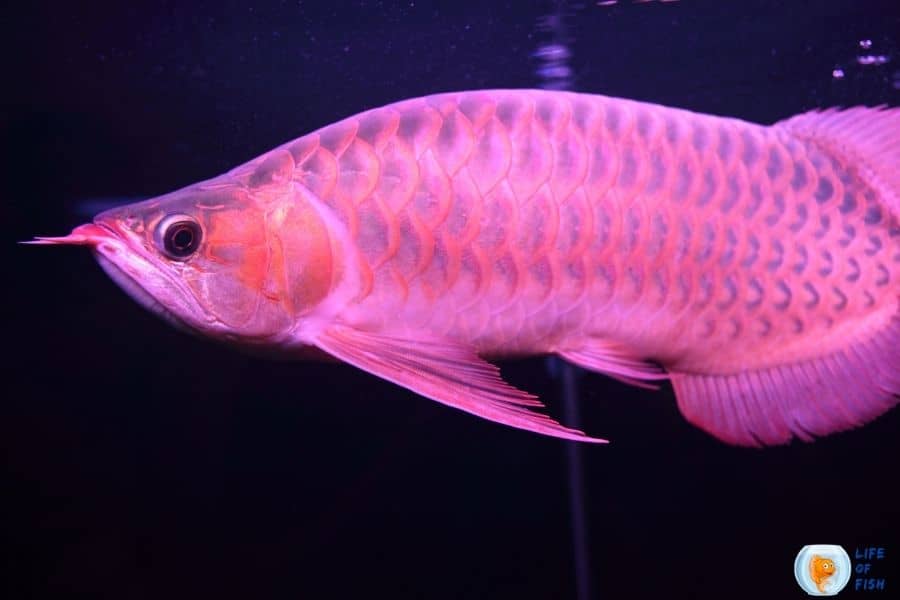
Red Asian Arowana care
Red Asian Arowanas are tropical freshwater fish. So, you should provide tropical water conditions in their tank.
Surprisingly, caring for these fish is quite easy despite their size. They are resilient fish species that can tolerate various water conditions.
However, because of their massive size, people find it hard to care for these fish.
Red Arowana size
Red Asian Arowanas can reach about 35 inches and almost 15lbs as an adult. Therefore, to house them, you should provide a large-sized sturdy tank.
Red Arowana tank size
With such a massive size, Red Arowanas need large tanks. You can’t keep even a juvenile fish in a 30-gallon aquarium, and sometimes the fish may not even fit into this tank.
For their size, you should provide at least a 250-gallon tank for a single fish. This is the bare minimum size, and if you can afford it, you should seek a more large-sized one.
How many Red Arowana should be kept together?
Like any other Arowanas, you can not keep more than one Red Arowana in one tank unless you introduced them to one tank at their juvenile age.
If you have seen more than one Arowanas in one tank, they have probably been there since an early age.
Tank setup
Setting up the tank for Red Arowana is pretty straightforward.
Even though the tank itself is costly, you don’t need to spend much more than on the filtration, lights, and water heater for your tank.
Arowanas do not care about imitating their natural habitat as long as they get ideal water conditions and enough food to eat.
Decorations
Red Asian Arowanas are surface dwellers. So, they don’t care much about what’s on the bottom of the tank.
If you like, you can decorate it, but we recommend adding a minimum number of decorations to keep things clean.
Substrate
Since these fish are surface dwellers, you can keep your tank with no substrate. However, if you’re going to add a substrate, use sand rather than gravel.
Lighting and Heating
Red Arowana care does not require a highly intense lighting system. If you like, you can add such systems for beautification purposes (although not necessary).
However, make sure the lights are fixed above the waterline to prevent your fish from burning.
These fish do not require high-intensity lights because they are nocturnal in nature.
Filtration and other equipment
Arowanas are massive fish that produce lots of waste. Therefore, they require a powerful filtration system.
You can use external filters for this purpose. But, you should change the filter cartridge frequently to maintain water quality at its peak.
Since these are tropical freshwater fish, they require warm water conditions in their surrounding. Therefore, you may need to install an aquarium water heater to keep tropical water conditions.
Do not add any air stone in an Arowana tank because they consider it a threat and attack them.
When adding a filter, take the necessary steps to minimize water movement because these fish do not like much water current.
Tank cover
Adding a tank cover is crucial in an Arwana tank because Red Arowanas have strong jumping abilities and can jump from the tank even though you thought it was impossible.
Additionally, the stand should be strong and sturdy enough to hold a massive tank.
Water quality condition
Asian Arowana care requires the water temperature to be around 75-86° F (24-30° C). So, you will have to provide this temperature through a water heater if you live in a cold area.
The pH of the water should be between 6.0 and 7.0, in the neutral range.· Further, the water should be soft to moderately hard for these fish.
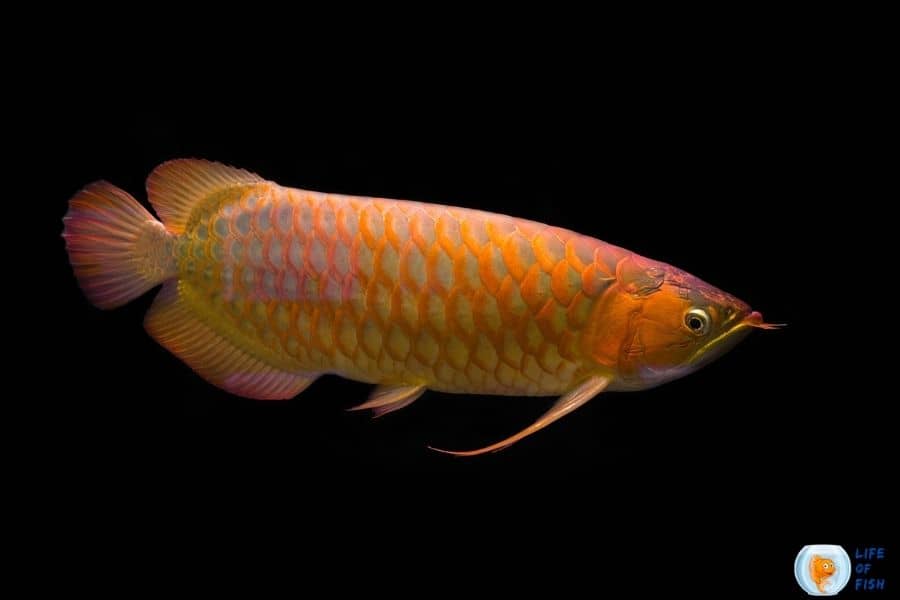
Red Arowana breeding
Breeding of Red Arowana is impossible in captivity. Their size and aggressive nature are what stop them from breeding at aquariums.
Further, the perfect water conditions for the reproduction of these species are still unknown for home aquarists.
Many Red Asian Arowanas sold at the market are actually wild-caught ones, which is why they are prohibited from keeping in the USA.
However, some specialized breeders commercially breed these fish under dedicated environments.
They usually microchip the offspring when they reach about 4 inches long. You can legally own these captive-bred Arowanas with a license.
Like other Arowana species, these are also egg-laying mouthbrooders. These fish start breeding when they reach maturity after about 3 to 4 years. They usually reproduce in the spring season.
It’s very difficult to determine the gender of this fish. To identify the gender of these fish, experts need to inspect their gonads through x-ray imaging or dissections.
However, you can differentiate between male and female Red Asian Arowanas by looking at their bodies.
Females are plumper than males because they store eggs during the breeding season.
After spawning, the males brood the eggs inside his mouth for about three to four weeks.
During this period, male Red Asian Arowanas show high levels of parental care. He will not eat anything during this period because he wants to protect the eggs inside his mouth at all costs.
Afterward, the male releases the fry after around two months when they are strong enough for independent survival.
Further, during this time, the female also cares for the young Arowanas by protecting them from predators and leading them around the tank.
The number of eggs varies with the size of Red Arowana. However, an average adult can lay up to 150 eggs at a time during the breeding season.
Once the fry reaches juvenile age, they can find food on their own. Usually, aquarists receive juvenile Arowanas to raise at their home aquariums.
So, you can feed them with small aquarium fish and crustaceans without any problems.
Special tips
Since red Asian Arowanas have bright red color on their body, the whitish, bluish, or greenish background may not suit these fish.
The best background for red color is black. Therefore, try to decorate your Red Arowana tank with a darker theme to highlight your fish more.
How to feed Red Arowana?
Red Asian Arowanas are carnivorous fish species that feed on smaller fishes rather than pellets.
As long as your tank is big enough, it is better to avoid feeding them with pellets because pellets are not natural for these fish.
Some fish who were acclimated during their juvenile stage may eat pellet food, but they get used to them soon after you feed them live or frozen food. Then they will not eat pellets again.
Use live foods like tubifex, brine shrimp, or daphnia during the early stages until your Red Asian Arowana starts feeding on other aquarium food.
During this period, you should feed your fish at least four times a day. Later, you can gradually reduce the amount of food given to your fish.
You can feed your Red Arowana with medium-sized fishes like guppies, platies, or minnows.
You should create an environment that closely resembles their natural habitat in nature. So, try to include other types of meaty foods in their diet.
Further, red Asian Arowanas are also fond of invertebrate food like feeder crickets, earthworms, or blood worms.
However, if you don’t culture these creatures at home, they are not safe for your fish as they may contain harmful parasites and diseases.
Carotenoids are pigments that give Arowanas their brilliant red color. You can get carotenoids in many different foods, including beef liver and salmon fish.
So, supplement their diet with carotenoid-rich food to get a bright red color hue.
Red Asian Arowanas tend to jump when they feed, and they can jump for few feet high. So, having a strong lid is a must.
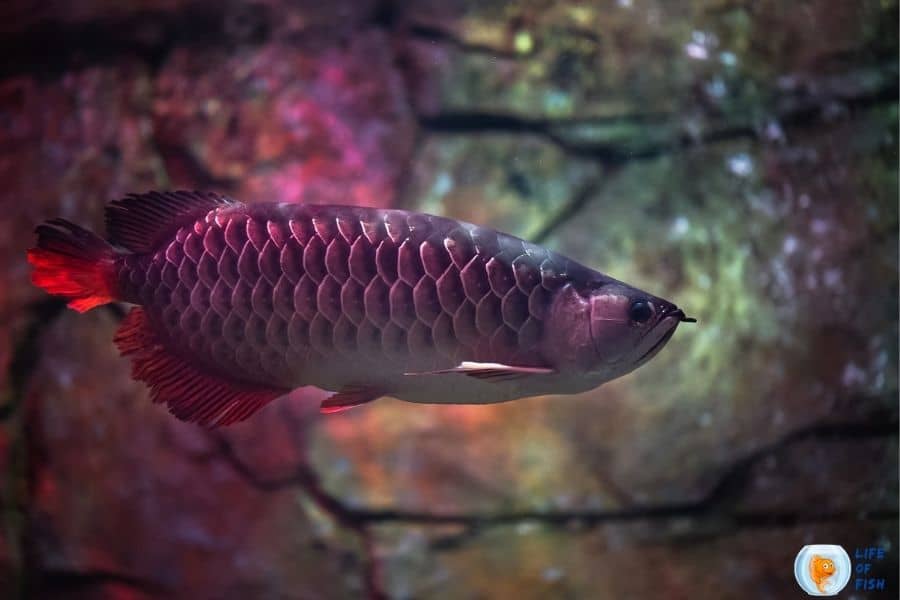
What fish can live with Red Arowana?
Arowanas prefer being alone, and they tend to fight with their own kind. So, always try to keep only one fish in one tank.
However, you can keep more than one of these fish if you have a big-sized pond/lake and if they are still juveniles.
Juvenile Red Asian Arowanas are less aggressive than mature Arowanas. If they are introduced at the juvenile ages, you can keep more than one Arowanas together for life.
However, you need to provide enough personal space for each fish.
Juvenile Arowanas can also get along with some other large fish species as well. However, when you choose other fish, keep in mind that they should be able to defend themselves if Arowanas attack them.
Some suitable Red Arowana tankmates are,
- Large catfish
- Parrotfish
- Silver Dollar Fish
- Large Plecos
- Bichir
- Jaguar Cichlid
- Pacu
- Green Terror Cichlid
Arowana is a carnivorous species that prefer eating smaller fishes. So, they can kill and eat other small species of aggressive fish as well.
In fact, some Arowanas have been known to eat anything from goldfish to large cichlids. So, it is better to avoid any other smaller fish species with Red Asian Arowanas.
Some Arowanas tend to starve for days and again eat large amounts of food after starving. If your fish is like this, don’t be afraid, they are just following nature.
In the wild, these fish don’t get to eat every day. But, still, they survive because of their massive bodies.
Some fish follow this habit even in captivity. So, there is nothing to be afraid of.
Read Next: Arowana Tank Size | 9 Crucial Facts You Should Know |
